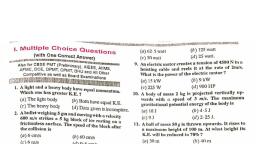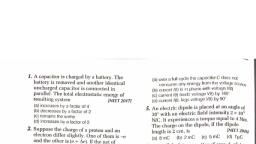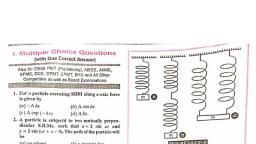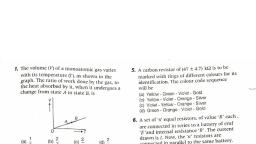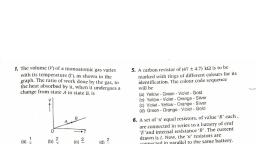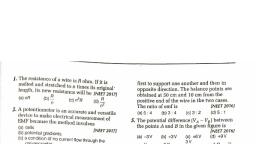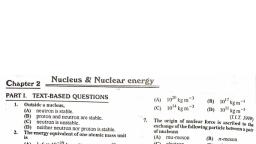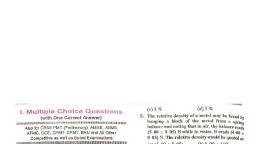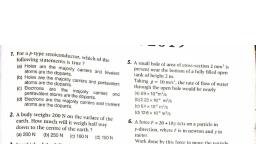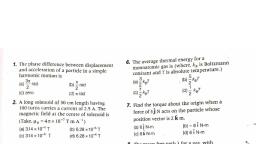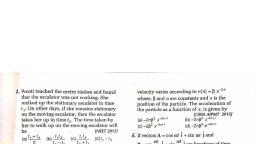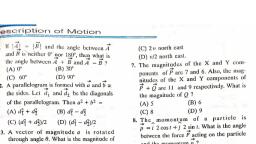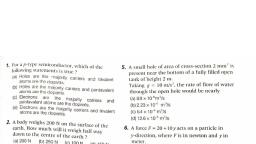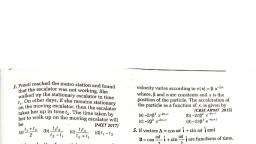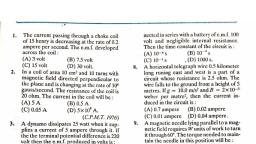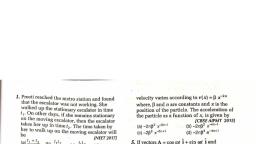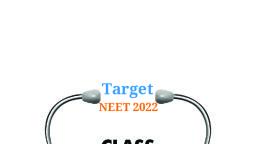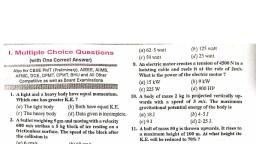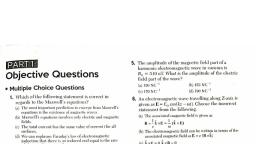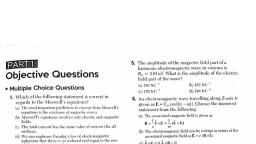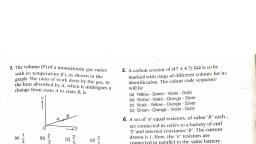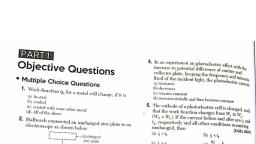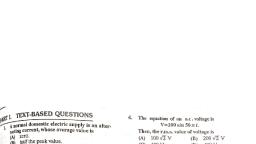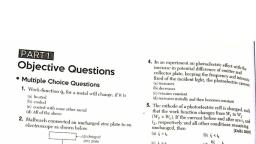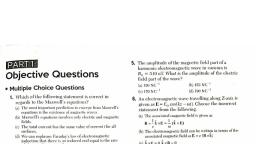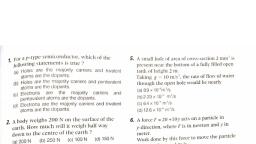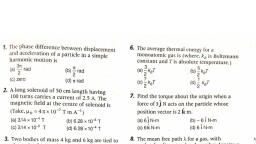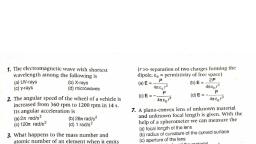Page 1 :
LET, , escription of Motion, , me i - . and the angle between A., an is neither 0° n . i, the angle between 4 , on, “ ., , (A) 0° (B) 30° :, (C) 60° (D) 90°, , A parallelogram, is formed with a and B at, the sides. Let d, and d, be the diagonals, of the parallelogram. Then a? + b? =, A)di+a (B)G-h, , (C) dj + 43/2 (D) (dj - 2, , . A vector of magnitude @ is rotated, , through angle 8. What is the magnitude of, , the change in the vector ?, , (A) 2a sin 6/2 (B) 2.4 cos 6/2, , (C) 2a sin6 (D) 2 a cos 6., , 4. Given that P is a point on a wheel rolling, on a horizontal road. The radius of the, wheel is R. Initially the point P is in contact, with the ground. The wheel rolls through, half the revolution, What is the displacement of the point P ?, , (A) aR (B) 2 aR, (C) (Va241)R (D) (Wat 4K., , 5, Which of the following is a vector ?, (A) Pressure, , (B) Surface tension, (C) Moment of inertia, (D) None of the above., , 6. A particle of mass m moving with velocity, v northwards, collides with another particle of mass m moving with velocity v, eastwards. After the collision the two particles coalesce. What is the velocity of the, new particle ?, , (A) v2 v north east, (B) v/V¥2 north east, , 123, , 10., , 11., , 12., , (C) 2v north cast, (D) v/2 north east., , . The magnitudes of the X and Y com=, , ponents of P arc 7 and 6, Also, the magnitudes of the X and Y components of, > —_> . *, P +Qare li and 9 respectively. What is, the magnitude of Q ?, , (A) 5 (B) 6, , (C8 (D) 9, , . The momentum of a particle is, ne x, , p =i 2cost+j 2 sin t. What is the angle, between the force F acting on the particle, and the momentum p ?, , (A) 45° (B) 90°, , (Cc) 135° (D) 180°, , . The sum of the magnitude of two vectors, , is 18 and the magnitude of their resultant, is 12. If the resultant is perpendicular to, one of the vectors, then what are the magnitudes of the two vectors., , (A) 5, 13 (B) 6, 12, , (C) 7, 11 (D) 8, 10, , A rigid ball moving with momentum pstrikes a plain horizontal surface and is, reflected with no change in the magnitude, of momentum. If the angle of incidence of, the ball is 45°, what is the angle between, the initial and final momenta of the ball ?, (A) 30° (B) 60°, , (C) 90° (D) 120°, , A body is moving along a circular path, with constant speed v. What is the change, in velocity, when the angle described by, the body at the centre of the circle be ?, (A) Zero (B) 2 v sin (6/2), , (C) 2u sin 8 (D) 2 v sin 24., , A large number of particles are moving
Page 2 :
Pa), each with velocity © having dircetions of, motion randomly distributed, What is the, average relative velocity between any two, particles averaged over all the paits ’, , (Av (a) : a, ) »,, , ©) ‘ + (D) dare, , 13. The magnitude of the sum of the two vee, , tors is equal to the difference of their mag,, nitudes, What is the angle between the, , vectors ?, (A) 0° (B) 45°, (C) 90° (D) 180",, , A swimmer can swim in still water with, speed v and the river flowing with velocity, v/2. To cross the river in shortest distance,, he should swim making angle @ with the, upstream, What is the ratio of the time, taken to swim across in the shortest time to, that in swimming across over shortest, , 14,, , distance ?, (A) cos 6 (B) sin 0, (C) tan 0 (D) cot 8., , 15, Two vectors P &Q are inclined to each, other at angle 6. Which of the following, is the unit vector perpendicular to both, , P&Q?, >, , (A) Exg wy xe, P.O sin®, , am EXD Pxd, , (©) PO sind (0) PQ cosé, , 16. A particle of mass m is fired from the, origin of the co-ordinate axes making angle, 45° with the horizontal, After time ¢ its, position vector igr = 34 + 4j and velocity, is v =4i —3j. What is the angular, momentum of the particle at that instant ?, , are BT, (C) 25k (D) - 25k, , -~ —s 7, Given that Pweg RMP +0 =,, then the angle between P&R is, If, , ~, > Fy R =0, then the angle between, p+art, , 19., , 20,, , 21., , 22,, , HAIN HAS ey, r & K is Oy, What is the colation betweeg, A, & Ay?, (AVA, = ey, (C) 0, = %, Two balls are rolling on a flat smooth, table, The velocity components of ong are, jand ¥Ij and that of the other are 2 and, , 2), UW both start moving simultancously, from the same point, what is the angle be, tween their paths ?, , (I) A) = A/2, (D) None of the above, , (A) ‘15° (B) 30°, (c) 48° (D) 60°. ., The diagonals of a parallelogram are 2 i, , and 2 j, What is the arca of the parallelogram ?, (A) 0°5 units, (C) 2 units, - ol;, Resultant of the two vectors Fy, & Fy is of, , (B) 1 unit, (D) 4 units,, , magnitude 2. If Fy is reversed, then resultant is of magnitude Q. What is the value, of P2 + G2?, , (A) FU + 3, (©) 204 -F3), , If a vector P makes angles a, § and y, respectively with the X, Y and Z axes respectively, Then sin? a + sin? B + sin? y =, (A) 0 (B) 1, , (C)2 (D) 3, , It is found that a body hangs properly, when a force of 20 N cast and another, force of 30 N north acts on it, What is the, , magnitude of the single force that can do, the same ?, , (A) 10N, (C) 50 N, , (B) F¥-3, (D) 2 (FF + 9), , (B) 36 N, (D) None of the above., , + A weight W is suspended from a rope as, , shown in the figure, The rope is fixed at A, and passes over a frictionless pulley at P., The knot N through which HW is suspended, can move freely on the rope, Let Ty Tz
Page 3 :
BRAIN TEASERS, , and T, be the tensions in the three parts, , of the rope. Which of ., sai bieeeoen* the following rela, , , Ww, a ten-n-%, , (B), ©, , = 7, #7, =T;, , 2, Ww, 2, Ww, 7°17 hets, Ww, 2, , = T, #7, # Ty, , 24, In the above question, if the knot N is NOT, free to move on the rope, which of the following relations will be correct ?, , (A) T,=T=T73 ®) 14 T= 7%, (C) T; = 72 # 7 (D) T, # 7; # Ts, 25. The X and Y components of vector A have, numerical values 6 & 6 respectively and, that of A +B have numerical values 10, and 9, What is the numerical value of B ?, (B) 3, (c)4 (D) 5, 26. The point of application of a force, 5i_+ 4j,+ 10k newton is displaced from,, 21 +3) +4k metre to 1i +7j +8k, metre. What is the kinetic energy gained, by the system ?, (A) 93 (B) 115, (C) 495 (D) 81 J., 27. 100 coplannar forces each equal to 10 N, , 29., , 3., , 125, act on a body. Each force makes angle, 2/50 with the preceding force. What is the, resultant of the forces ?, , (A) 1000 N (B) 500 N, (C) 250 N (D) Zero,, The instantaneous height and position of a, projectile are given by, y = & — S¢ metre, and x = 6¢ metre, What is the initial speed of the projectile?, (A) 5 ms~! (B) 6 ms~?, (C) 8 ms-! (D) 10 ms~!., The electric potential at a point (x, y, z) is, given by: V = Sx + 4y — 62. What is, the electric field at that point ?, (A) -Si = 4 + 64, (B) Si -4j -6k, (C) 51-4] +6k, (D) 5744) +6k., , | Angle betwen PaGis 6, What is the, > 7 , value of P.Q xP?, , (A) P?.Q cos @, , (B) zero, , (C) P2Q sin 6 cos 6, , (D) P°Q sin 6., , A body of mass 2 kg is constrained to move, along Y-direction. When a force of, , 2 +5 + 7k newton acts on it and the, body is displaced chrough 10 m. The, , kinetic energy gained by the body is :, (A) 504 (B) 100), (C) 1505 (D) 350 J., , 32. A person standing on the escalator takes, , time f, to reach the top of a tower when, the escalator is moving, He takes time f, to reach the top of the tower when the, escalator is standing. How long will he take, if he walks up a moving escalator ?, , (A) Q-4, (B) +4, , (©) yh/y-y)— () 4b/ +9)
Page 4 :
33, A body is thrown upwards with velocity 30, , m/s and it reaches the highest point after, 2-5 s, What is the mean air resistance experineed by it, given that the mass of the, body is 50 g ? Take gy = 10 m/s?, , (A) 0-1.N (B) 0-2.N, , (C)0-4N (D) 1-0N, , 34. A pendulum has a ball of mass M attached, , to the string and is suspended from the, roof of a trolley. If the trolley rolls upwards, with acceleration a, then what is the angle, made by the string with the inclined plane,, Given thata = 5 m/s?, g = 10 m/s? and, the angle of inclination of the plane is 30°, , (A) cos—1(2/V3) (B) cot-! (2/v3), (©) sin (2/3) (D) tan=1 (2/V3), , 35. A particle moves with uniform accelera, tion and its average velocities are, V1 ,U2,U3 Over the successive intervals of, , time ),f,&f respectively. Then, (04 — v3)M(v2 ~ v4) =, , (A) (4-4)/(Q-&), , (B) ((-1)/(_ + &), , (C) (4) +) - ty), , (D) (4 + H)A(m + ty), , 36. A bus starts moving with acceleration, , 2ms~?. A cyclist 96 m behind the bus, , starts simultaneous towards the bus at 20, , m/s. After what time will he be able to, , overtake the bus ?, , (A) 4 seconds — (B) 8 seconds, , (C) 12 seconds —_ (D) 16 seconds., , 37. In the above question, after some times the, , bus will be left behind. If the bus continues, , ce ae the same acceleration, after, ime from the beginning, the bus will, , overtake the cyclist ” per, , (A) 10 seconds —_(B) 12 seconds, , (C) 14 seconds (1D) 16 seconds,, , 38. A body is thrown upwards with velocity, , 100 m/s and it travels 5 m in the last second, , of its upward journey. If the same body is, , thrown upwards with velocity 200 m/s,, , 39,, , 40., , 42., , BRAIN Th AG, what distance will it travel in its Lact o- ond, of upward journey ?, , (A) Sm (B) 10 m, (C) 20m (D) 25 m., A person throws balls into the air after, every second. The next ball is thrown when, , the velocity of the first ball is zero. How, high do the ball rise above his hand?, , (A) 2m (C) 5m, (C) 8m (D) 10m, For the given interval of time which of the, , following is single valued for a particle in, motion ?, , (A) Instantancous speed, (B) Instant velocity, , (C) Average speed, , (D) Average velocity., , « The time (¢) and displacement (x) are re, lated as : ¢ = ax? + bx. What is the acceleration of the particle at the origin of, the co-ordinate axes ?, , (A) —2ab3 (B) —2ab, , (C) -2a/b3 (D) — 2a/b, , A boat can go across a lake and return intime Ty at a speed V. On a rough day there, is uniform current at speed v to help the, onward journey and impede the return, , journcy. If the time taken to go across and, return on the rough day be 7, then 7/Ty=, , (A) 1-v7/7 (By —, , 1-vs/i, , 1, 2/2 ee, meres ©), , Two cars are moving in the same direction, with the same speed of 30 km/h, They are, separated by 5 km, What is the speed of, the car moving in the opposite direction if, it meets the two cars at an interval of 4, minutes ?, , (A) 15 kan/h, (C) 45 km/h, , (B) 30 km/h, (D) 60 km/h., , 44. A truck and a car are brought to a hault, , by applying the same breaking force. Both
Page 5 :
of them will come to rest after travelling, the same distance when they have the, , same: —, (A) mass (B) momentum, (C) velocity (C) kinetic energy., , 45. The shortest distance over which a car, , can be brought to rest by applying brakes, is 1m. If its speed is made 3 times, the car, can be brought to rest over a distance of :, , (A) 9 m (B) 6m, (C) 3m (D) 1 m.
